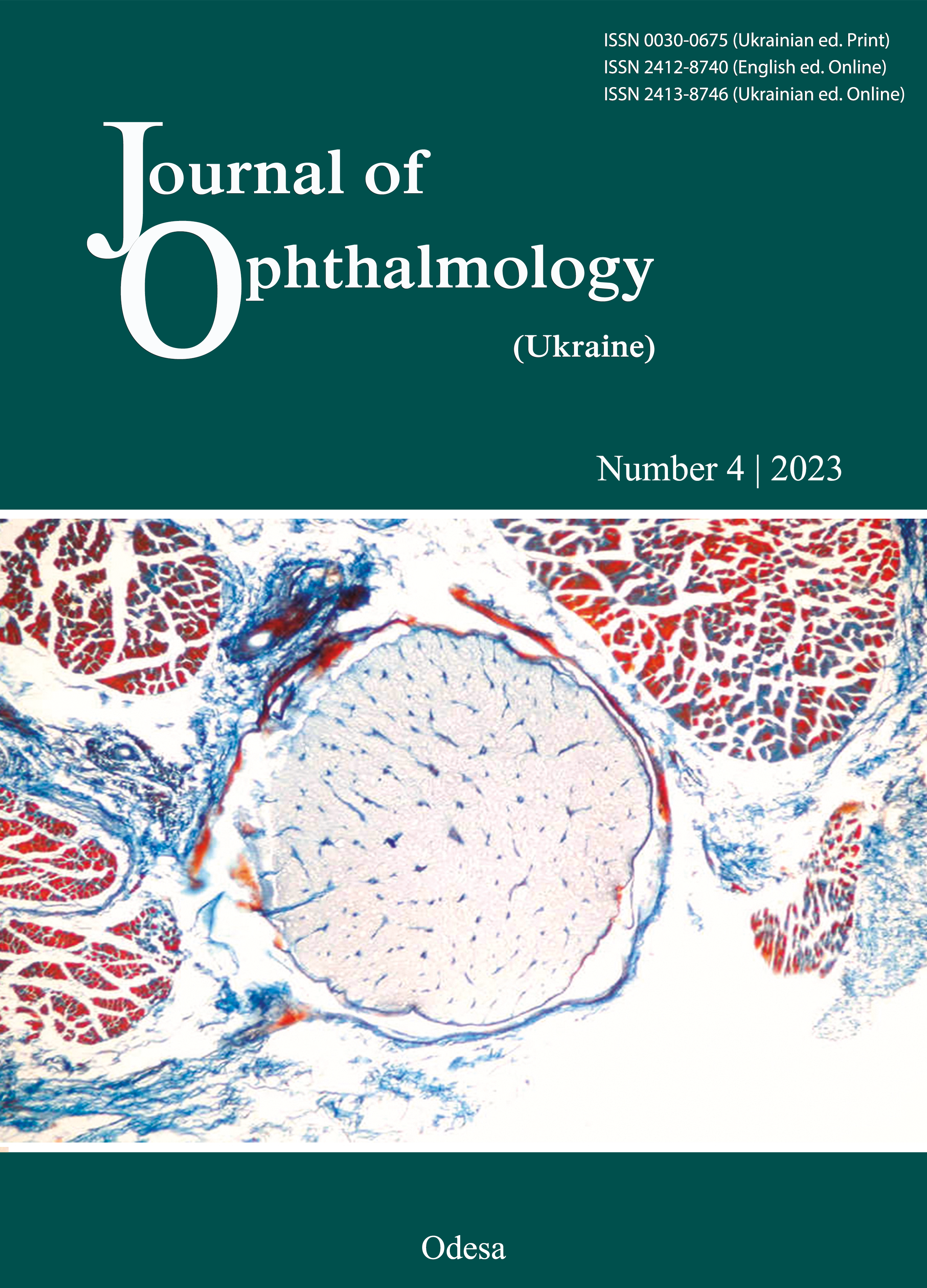Neurodegenrative changes in retina of rats with streptozotocin-induced diabetes under conditions of treatment with niacin-oxy-ethylidene-diphosphonate germanate (MIGU-4)
DOI:
https://doi.org/10.31288/oftalmolzh202345560Keywords:
streptozotocin-induced diabetes, retinopathy, niacin-oxy-ethylidene-diphosphonate germanate (MIGU-4), oxidative stress, neuroprotection, retinaAbstract
Background: Diabetes is accompanied by neurodegenerative changes in the retina. The determination of retinal function parameters under conditions of experimental diabetes may allow for the development of new approaches to pharmacological vision correction.
Purpose: To assess changes in the metabolic (lipid peroxidation and antioxidant defence) and functional characteristics (electroretinography (ERG)) of the retina in the rat with streptozotocin (STZ)-induced diabetes, treated with niacin-oxy-ethylidene-diphosphonate germanate (MIGU-4) and a reference drug, diazepam.
Material and Methods: Diabetes was induced intraperitoneally (i.p.) in Wistar male rats by streptozotocin (STZ 65 mg/kg). Four weeks thereafter, the rats received a two-week course of a daily dose of MIGU-4 (5.0 mg/kg or 25.0 mg/kg) or diazepam (0.5 mg/kg or 1.5 mg/kg). The electroretinogram (ERG) was obtained, the animals were euthanized and retinal malondialdehyde (MDA) levels and superoxide dismutase (SOD) and catalase (CAT) activity were determined.
Results: In rats with untreated STZ-induced diabetes, the retinal MDA level was 3.71 times increased and CAT activity was 35% lower, compared to controls, whereas the SOD activity was half of the activity found in controls (р < 0.05). In diabetic animals treated with MIGU-4 i.p. at a 25.0-mg/kg daily dose, the retinal MDA level was 63.2% lower, whereas the CAT activity and SOD activity were 41.9% and 27.6%, respectively, higher, than in untreated diabetic rats (р < 0.05). In diabetic animals treated with diazepam i.p. at a 1.5-mg/kg daily dose, the retinal MDA level was 59.2% lower, whereas the CAT activity and SOD activity were 44.4% and 32.1%, respectively, higher, than in untreated diabetic rats (р < 0.05). In untreated diabetic rats, the ERG b-wave amplitude was 39.2% lower, ERG a-wave and b-wave latencies, 23.4% and 14.0%, respectively, higher, and the a-wave amplitude recovery rate, 38.8% lower than in controls (р < 0.05). The use of a 25.0-mg/kg daily dose of MIGU-4 resulted in a 29.7% and 33.9%, respectively, increase in the ERG b-wave amplitude and the a-wave amplitude recovery rate compared to untreated diabetic rats (р < 0.05). The use of a 1.5-mg/kg daily dose of diazepam resulted in a 25.0% and 30.0%, respectively, increase in the above ERG parameters compared to untreated diabetic rats (р < 0.05). In untreated diabetic rats, the number of squares crossed (SK) was 29.4% lower (р < 0.05); the number of central squares crossed (CSC), 52.1% lower (р < 0.05); the number of upright postures (UP), 34.2% lower; and the defecation bolus number, 32.4% higher than in controls (р < 0.05). After MIGU-4 (25-mg/kg) withdrawal, there were no more differences in SK, CSC, UP and defecation bolus numbers between treated diabetic rats and controls. In addition, the number of CSC was 4.27 times lower than in controls, and half of that in untreated diabetic animals (р < 0.05). In diabetic rats treated with diazepam, the number of UP was 2.56 times lower than in controls (р < 0.05), and 40.7% lower than in untreated diabetic rats (р < 0.05), whereas the defecation bolus number was 40.5% higher than in controls (р < 0.05).
Conclusion: STZ-induced diabetes is accompanied by an impairment of the oxidant/ antioxidant balance in the retina with an increase in retinal MDA, decrease in retinal SOD and CAT activity, and ERG abnormalities such as reduced ERG amplitude and increased ERG latency. A course treatment with niacin-oxy-ethylidene-diphosphonate germanate (MIGU-4) i.p. at a daily dose of 25.0 mg/kg provides for a decrease in retinal MDA and an increase in retinal SOD and CAT activity and ERG wave amplitude The withdrawal of a two-week treatment with MIGU-4 i.p. at a daily dose of 25.0 mg/kg decreased open-field anxiety-like behaviors, whereas the withdrawal of a two-week treatment with diazepam i.p. at a daily dose of 1.5 mg/kg increased open-field anxiety-like behaviors. The corrective effect of treatment with MIGU-4 corresponds to the corrective effect of treatment with diazepam.
References
Kresyun NV. [Electroretinogram changes in rats with streptozotocin-induced diabetes under conditions of the use of alpha lipoic acid and avastin]. Odeskyi medychnyi zhurnal. 2014;2(142):32-6. Ukrainian.
Kresyun NV. [Neurodegenerative changes in retina of rats with streptozotocin-induced diabetes under different conditions of experimental treatment]. Zaporizkyi medychnyi zhurnal. 2014;4:21-5. Ukrainian.
Kresyun NV, Godlevskii LS. Superoxide dismutase and catalase activities in the retina during experimental diabetes and electric stimulation of the paleocerebellar cortex. Bull Exp Biol Med. 2014;158:206-8. doi: 10.1007/s10517-014-2723-6. https://doi.org/10.1007/s10517-014-2723-6
Kowluru RA, Kowluru A, Mishra M, Kumar B. Oxidative stress and epigenetic modifications in the pathogenesis of diabetic retinopathy. Prog Retin Eye Res. 2015;48:40-61. https://doi.org/10.1016/j.preteyeres.2015.05.001
Godovan VV, Kresyun VJ. [State of cellular antioxidant protection system in galactosamine hepatitis and use of derivatives of oxy-ethylidene-diphosphonate germinate. Report 1]. Odeskyi medychnyi zhurnal. 2007;4(102):36-41. Ukrainian.
Godovan VV, Kresyun VJ. [State of cellular antioxidant protection system in galactosamine hepatitis and use of derivatives of oxy-ethylidene-diphosphonate germinate. Report 2]. Odeskyi medychnyi zhurnal. 2007;5(103):5-10. Ukrainian.
WadaT, HanyuT, Nozaki K, Kataoka K, Kawanti T, Asahi T, et al. Antioxidant activity of Ge-132, a synthetic organic germanium, on cultured mammalian cells. Biol Pharm Bull. 2018;5:749-53. doi: 10.1248/bpb.b17-00949. https://doi.org/10.1248/bpb.b17-00949
Voloshenkov DB, Kashchenko OA, Godovan VV, Shandra OA. [Impact of derivatives of germanium diphosphonate with nicotinamide, nicotine acid and magnesium on muscle rigidity, tremor and salivation in rats and mice]. Odeskyi medychnyi zhurnal. 2005;4 (90):21-4. Ukrainian.
Jozaa Z, Tamimi AL, Bin Mowyna MN, Al Faris NA, Alagal RI, El-kott AF, AL-Farga AM. Fisetin protects against streptozotocin-induced diabetic cardiomyopathy in rats by suppressing fatty acid oxidation and inhibiting protein kinase R. Saudi Pharm J. 2021 Jan; 29(1): 27-42. https://doi.org/10.1016/j.jsps.2020.12.003
Kraeuter AK, Guest PC, Sarnyai Z. The open field test for measuring locomotor activity and anxiety-like behavior. Methods Mol Biol. 2019;1916:99-103. https://doi.org/10.1007/978-1-4939-8994-2_9
Fernández Hurst N, Zanetti SR, Báez NS, Bibolini MJ, Bouzat C, Roth GA. Diazepam treatment reduces inflammatory cells and mediators in the central nervous system of rats with experimental autoimmune encephalomyelitis. J Neuroimmunol. 2017;313:145-51. https://doi.org/10.1016/j.jneuroim.2017.09.012
Durak IZ, Yurtarslanl O, Canbolat O, Akyo lA. A methodological approach to superoxide dismutase (SOD) activity assay based on inhibition of nitroblue tetrazolium (NBT) reduction. Clin Chim Acta. 1993;214(1):103-4. https://doi.org/10.1016/0009-8981(93)90307-P
Weydert CJ, Cullen JJ. Measurement of superoxide dismutase, catalase and glutathione peroxidase in cultured cells and tissue. Nat Protoc. 2010;5(1):51-66. https://doi.org/10.1038/nprot.2009.197
De Leon JAD, Borges CR. Evaluation of oxidative stress in biological samples using the thiobarbituric acid reactive substances assay. J Vis Exp. 2020; (159):10.3791/61122. https://doi.org/10.3791/61122
Lowry ON, Rosenbrough NJ, Tarr AL, Randall RJ. Protein measurement with the folin phenol reagent. J Biol Chem. 1951;193(1): 265-75. https://doi.org/10.1016/S0021-9258(19)52451-6
Downloads
Published
How to Cite
Issue
Section
License
Copyright (c) 2023 Kresyun V. I., Al-Nadawi N. D.

This work is licensed under a Creative Commons Attribution 4.0 International License.
This work is licensed under a Creative Commons Attribution 4.0 International (CC BY 4.0) that allows users to read, download, copy, distribute, print, search, or link to the full texts of the articles, or use them for any other lawful purpose, without asking prior permission from the publisher or the author as long as they cite the source.
COPYRIGHT NOTICE
Authors who publish in this journal agree to the following terms:
- Authors hold copyright immediately after publication of their works and retain publishing rights without any restrictions.
- The copyright commencement date complies the publication date of the issue, where the article is included in.
DEPOSIT POLICY
- Authors are permitted and encouraged to post their work online (e.g., in institutional repositories or on their website) during the editorial process, as it can lead to productive exchanges, as well as earlier and greater citation of published work.
- Authors are able to enter into separate, additional contractual arrangements for the non-exclusive distribution of the journal's published version of the work with an acknowledgement of its initial publication in this journal.
- Post-print (post-refereeing manuscript version) and publisher's PDF-version self-archiving is allowed.
- Archiving the pre-print (pre-refereeing manuscript version) not allowed.












